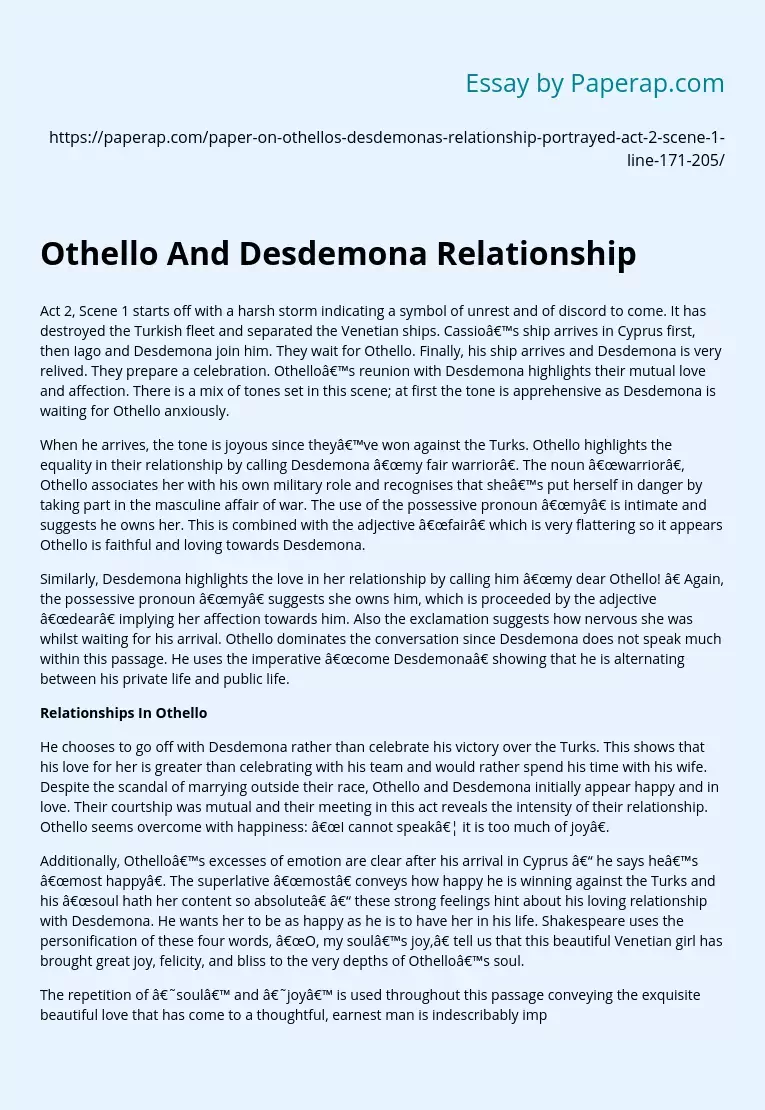Othello And Desdemona Relationship
Act 2, Scene 1 starts off with a harsh storm indicating a symbol of unrest and of discord to come. It has destroyed the Turkish fleet and separated the Venetian ships. Cassio’s ship arrives in Cyprus first, then Iago and Desdemona join him. They wait for Othello. Finally, his ship arrives and Desdemona is very relived. They prepare a celebration. Othello’s reunion with Desdemona highlights their mutual love and affection. There is a mix of tones set in this scene; at first the tone is apprehensive as Desdemona is waiting for Othello anxiously.
When he arrives, the tone is joyous since they’ve won against the Turks. Othello highlights the equality in their relationship by calling Desdemona “my fair warrior”. The noun “warrior”, Othello associates her with his own military role and recognises that she’s put herself in danger by taking part in the masculine affair of war. The use of the possessive pronoun “my” is intimate and suggests he owns her.
This is combined with the adjective “fair” which is very flattering so it appears Othello is faithful and loving towards Desdemona.
Similarly, Desdemona highlights the love in her relationship by calling him “my dear Othello! ” Again, the possessive pronoun “my” suggests she owns him, which is proceeded by the adjective “dear” implying her affection towards him. Also the exclamation suggests how nervous she was whilst waiting for his arrival. Othello dominates the conversation since Desdemona does not speak much within this passage. He uses the imperative “come Desdemona” showing that he is alternating between his private life and public life.
Relationships In Othello
He chooses to go off with Desdemona rather than celebrate his victory over the Turks. This shows that his love for her is greater than celebrating with his team and would rather spend his time with his wife. Despite the scandal of marrying outside their race, Othello and Desdemona initially appear happy and in love. Their courtship was mutual and their meeting in this act reveals the intensity of their relationship. Othello seems overcome with happiness: “I cannot speak… it is too much of joy”.
Additionally, Othello’s excesses of emotion are clear after his arrival in Cyprus – he says he’s “most happy”. The superlative “most” conveys how happy he is winning against the Turks and his “soul hath her content so absolute” – these strong feelings hint about his loving relationship with Desdemona. He wants her to be as happy as he is to have her in his life. Shakespeare uses the personification of these four words, “O, my soul’s joy,” tell us that this beautiful Venetian girl has brought great joy, felicity, and bliss to the very depths of Othello’s soul.
The repetition of ‘soul’ and ‘joy’ is used throughout this passage conveying the exquisite beautiful love that has come to a thoughtful, earnest man is indescribably impressive. For him it is “heaven” on earth. Othello tells Desdemona that “if after every tempest come such calms, may the wind blow till they have wakened death”. This image is prophetic – a greater ‘storm’ is about to hit their relationship as Iago puts his plan into action. Thus line also hints that death will “wakened” by the end of the play.
There is imagery of death through the words of “die”, “fear”, “death” and “hell” suggesting the relationship will fall apart due to Iago. The semantic field of death portrays an image of what will happen later on in the play making the audience uneasy. Shakespeare includes different type of sentence structure. In this passage, Othello and Desdemona use long, compound sentences: “and this, and this, the greatest discords be that e’er our hearts shall make. ” Using long sentence convey their love towards each other as they explain their feelings to one another.
Shakespeare also includes rules of conversations; adjacency pairs are used, such as when Desdemona says “the heavens forbid but that our loves and comforts should increase, even as our days to grow”, to which Othello replies “amen to that, sweet powers! ” This shows that both of them are loving towards each other, as they are obeying turn-taking and Grice’s maxim on quantity. However, Iago breaks the adjacency pair by interrupting “O, you are well tun’d now! But I’ll set down the pegs that make this music, as honest as I am” and Othello replies with a short imperative “come, let us to the castle. It is evident that Iago is not respectful as he is impatient for them to finish their conversation and so he disrupts the conversation allowing the play to move on.
In conclusion, Shakespeare uses several techniques to show the relationship between Othello and Desdemona in this passage. Love and affection is used throughout, particularly when Othello says he has “found great love” and is “most happy”. Furthermore, Shakespeare uses imagery, affectionate mode of addresses, imperatives and adjacency pair to show love within the relationship.
Othello And Desdemona Relationship. (2019, Dec 05). Retrieved from https://paperap.com/paper-on-othellos-desdemonas-relationship-portrayed-act-2-scene-1-line-171-205/

